When you think of winter, chances are you think of curling up in front of a fire with a blanket, a hot drink and a good book. While some regions of Australia may only need a light jumper to combat the ‘cold’ months, for others, nothing short of three thick layers will do – and that’s just when you’re inside! But while many turn to modern heaters or air conditioning systems to chase away the winter chill, there’s not much that can compete with a fireplace when it comes to creating some ambience as well as warmth.
So, what should you consider when it comes to actually buying and installing a fireplace in your house, and how much will the average fireplace cost you? Canstar Blue stokes the flames on everything you need to know about fireplaces.
Types of Fireplaces
While all fireplaces will achieve the same goal, how they generate this heat is what differentiates them from each other. Fireplaces are available in multiple fuel types – wood, gas, ethanol and electric – with each type subsequently broken into subcategories based on style and design. Learn more about each fuel type below.
Wood fireplace
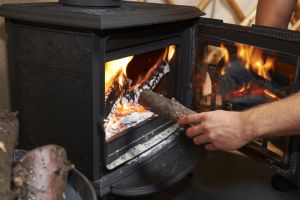
Likely what you envision when you think of a fireplace, a wood burning fireplace does just that – burns wood to generate light and heat. These fireplaces can be further classified as open hearths, enclosed fireplaces or inserts, closed combustion stoves, as well as free standing fireplaces, giving you plenty of options to choose from. However, as you’ll be burning wood, you’ll often have to consider a chimney or other type of ventilation to accompany this type of fireplace, meaning that the installation and design process will often be a larger undertaking in comparison to other fireplace types, and better suited to those building a house from scratch or renovating.
Gas fireplace
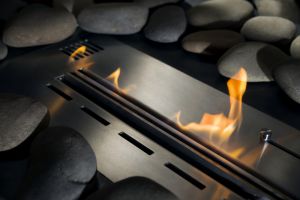
A middle ground between the traditional wood fireplace and the more modern electric fireplace, a gas fireplace is usually powered by natural or propane gas, and can be controlled by simply turning a knob to restrict or increase the amount of gas released to fuel the fire. However, like wood burning fireplaces, installing a gas fireplace can be a big undertaking, as you’ll have to connect the fireplace to the gas main, which can prove difficult in established homes.
Ethanol fireplace
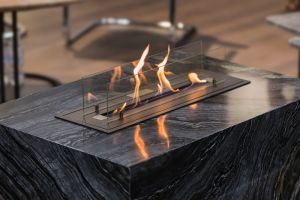
One of the latest additions to the fireplace market, ethanol fireplaces are traditionally the easiest type to install and fuel, as most ethanol fireplaces give off little waste or smoke, meaning there is little need for ventilation. Fueled by pouring ethanol fluid into the burner, an ethanol fireplace can also be used as a room centerpiece or wall feature, with most models able to be easily moved and installed. However, if you’re simply looking to keep warm, an ethanol fireplace may not be your best bet, with ethanol flames generally giving off less heat than other types of fireplaces.
Electric fireplace
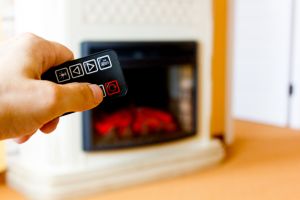
Electric fireplaces are ideal for those wanting to get the warmth of a wood or gas burner but don’t have the ventilation or gas mains connection available. As you may guess, electric fireplaces work by simply plugging them into an electric outlet, although you may get a bit hot under the collar when your energy bill comes around if you’re not careful. Electric fireplaces are ideal for those wanting to install a fireplace in their home without having to renovate the whole house. An added bonus is that most electric models can also be turned to a ‘flame only’ setting, giving you the cozy aesthetic without making you sweat.
What to consider when buying a fireplace
Fireplaces are generally not a cheap purchase – and aren’t something you can simply pop in the cupboard if you don’t like it – so there’s a few keys areas to consider before you warm to the idea of having one in your home. Areas to consider include:
- Type: deciding on the fuel type will be an important decision to make, as it will influence the installation process, the initial cost, as well as maintenance costs, in addition to what style and design you can choose to fit your home décor. If you’re buying a fireplace for an existing house, your options will be limited, but if you’re renovating or building from scratch, it’s best to work with a professional to ensure you get the best fit for your house, and that the installation meets safety standards.
- Purpose: before spending your hard-earned money, it’s important to consider why you’re buying a fireplace in the first place. Are you buying it for warmth, aesthetic, or as a selling point if you decide to sell your house further down the line? Installing a fireplace is potentially the most expensive way to heat your house in terms of upfront cost, but it can be hard to beat if you’re aiming for an aesthetic feature in your living room.
- Cost: like most purchases, the price tag can be the deciding factor in which product, brand or model that you walk out the door with. Fireplaces aren’t cheap, but there is a significant price difference between fireplace types, with freestanding models generally cheaper than built-in models, and ethanol heaters cheaper to install than woodburning fireplaces. Keeping an eye on the installation cost will also ensure you aren’t burnt by the final bill.
How much does a fireplace cost?
There’s no set price tag for a fireplace, with plenty of variables influencing the final cost. However, some fireplaces can be purchased for as little as a few hundred dollars, while others will cost you thousands of dollars – and that’s not including the installation and ventilation costs. To ensure you’re getting the best price, be sure to shop around and to get your house properly measured and evaluated for an accurate installation quote.
How to install a fireplace
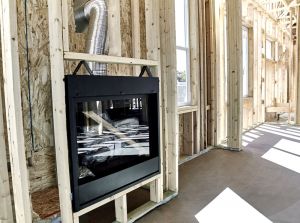
Installing fireplaces in your home – particularly those built-in to your house – are strictly regulated by governing bodies, with rules and regulations also varying from state to state. You will have to have a qualified professional install and oversee the process, with dedicated businesses out there for such an undertaking. As a result, unless you’re purchasing a freestanding fireplace unit, it’s best to consult with a professional before buying a fireplace to ensure you’re getting the best model for your house, and your safety.
Do all fireplaces need a chimney?
Not all fireplaces will need a chimney or ventilation system, but this will depend on what fuel you’re burning. Wood burning and gas burning fireplaces will need a ventilation system to remove fumes and smoke, while ethanol and electric fireplaces traditionally won’t need a ventilation system installed. If you do install a ventilation system or chimney, it’s important that you regularly clean and maintain it to ensure that you aren’t polluting your home with smoke or fumes, especially if it’s been a while since you last used your fireplace.
Where can I buy a fireplace?
Fireplaces are available to be purchased at fireplace specialty stores, with many retailers additionally offering installation services to help you get your purchase settled into your home. However, smaller freestanding fireplaces such as wood burning heaters and stoves can be purchased at retailers such as Barbecues Galore and other outdoor entertainment and heating stores.
Is it worth installing a fireplace in my house?
A fireplace can make a house a home, but for those who aren’t looking to renovate or build a house from scratch, it may not be worth the effort, as installing a traditional wood burning fireplace not only requires you to have a space big enough to house it, but a ventilation system as well. If you’re set on some flames as a centerpiece, a freestanding unit or an ethanol fireplace could be a more affordable option, or at least an option that requires significantly less effort to install. At the end of the day, sitting in front of a fireplace can be a nice way to spend the winter, which may be all the reasoning you need, although it’s best to do your research so you don’t get lost in the heat of the moment. If you can’t manage to squeeze a fireplace inside your home, why not check out our guide on fire pits to help you enjoy a night under the stars.
Picture credits: Carol A Hudson/shutterstock.com, SpeedKingz/shutterstock.com, Stock Image/shutterstock.com, Olga Prava/shutterstock.com, Sharaf Maksumov/shutterstock.com, Pamela Au/shutterstock.com.


Share this article